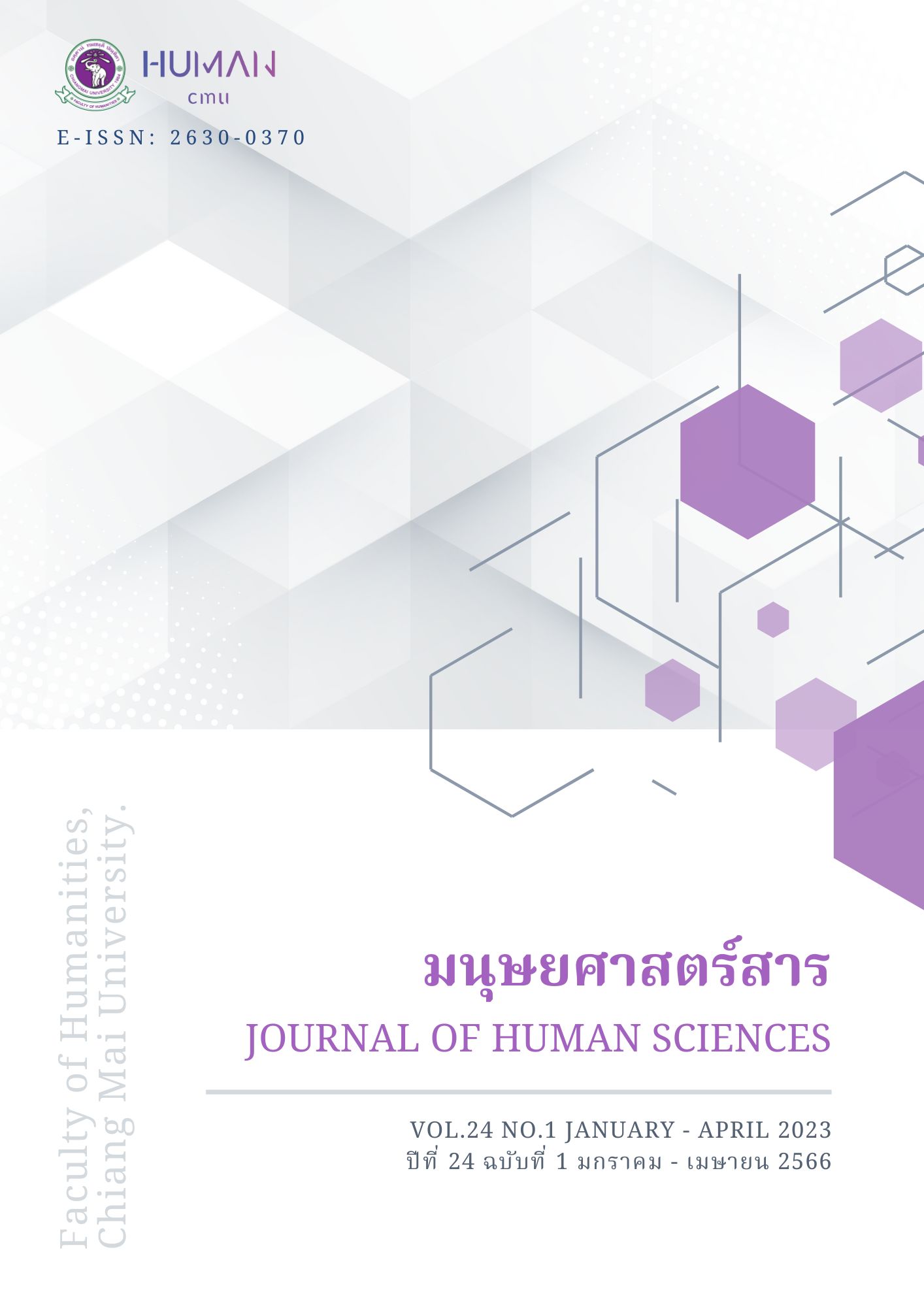การ เล่าเรื่องอาหารพื้นถิ่นอย่างมีส่วนร่วมเพื่อการขับเคลื่อนเมืองท่องเที่ยวเชิงวัฒนธรรมจังหวัดพิษณุโลก
Main Article Content
บทคัดย่อ
การยกระดับการท่องเที่ยวเชิงอาหารเป็นส่วนหนึ่งของแนวคิดทุนทางวัฒนธรรมที่ขับเคลื่อนและสร้างรายได้ให้กับประเทศและชุมชน การศึกษาครั้งนี้มีวัตถุประสงค์เพื่อแบ่งปันแนวคิดในการยกระดับจังหวัดพิษณุโลกให้เป็นเมืองและภูมิภาคแห่งการท่องเที่ยวเชิงอาหารด้วยวัฒนธรรมอาหารท้องถิ่น การศึกษานี้ใช้การออกแบบการวิจัยแบบผสมผสาน ข้อมูลถูกรวบรวมผ่านการสนทนากลุ่มของผู้มีส่วนได้ส่วนเสียหลัก 38 กลุ่ม ซึ่งประกอบด้วยเจ้าหน้าที่ของรัฐ สมาชิกท้องถิ่น นักท่องเที่ยว ทั้งการประชุมออนไลน์และนอกสถานที่ จากการค้นพบประเพณีอาหารพื้นถิ่นทั้ง 9 อำเภอ และนำข้อมูลที่ได้มาระดมความคิดเห็น วิเคราะห์แผนธุรกิจ และนำมาเป็นรูปแบบการเล่าเรื่องอาหารพื้นถิ่น อันจะนำไปสู่นวัตกรรมสื่อในการนำเสนออาหารพื้นถิ่นเพื่อการท่องเที่ยวในจังหวัดพิษณุโลก ผลการวิจัยพบว่าความหลากหลายทางชาติพันธุ์และการหลั่งไหลของผู้คนที่เข้ามาในจังหวัดพิษณุโลกนั้นมีความหลากหลายทางเชื้อชาติ ส่งผลให้ความหลากหลายและนิยามของอาหารท้องถิ่นแบ่งออกเป็น 2 ประเภท คือ อาหารพื้นเมืองดั้งเดิมและอาหารพื้นเมือง ซึ่งหากจะขับเคลื่อนได้ต้องสร้างความร่วมมือและข้อเสนอแนะดังที่กล่าวไว้ในบทความ โดยสรุปแสดงให้เห็นว่าพิษณุโลกมีศักยภาพในการเป็นจังหวัดท่องเที่ยวด้านอาหารตามหลักเกณฑ์ของยูเนสโก
Article Details

อนุญาตภายใต้เงื่อนไข Creative Commons Attribution-NonCommercial-NoDerivatives 4.0 International License.
เอกสารอ้างอิง
ผกาวดี ภู่จันทร์ และ โสรัจวรชุม อินเกต. (2563). สำรับอาหารพื้นถิ่นเมืองพิษณุโลก. กระแสวัฒนธรรม, 17(32), 4-16.
บ้านเมือง. (2565, 20 มีนาคม). วธ. ขับเคลื่อน soft power ดันอาหารของไทยสู่เวทีโลกผ่านสื่อบันเทิง. https://www.banmuang.co.th/news/education/273496
พิมพ์ชนก พุกสุข. (2559, 24 สิงหาคม). อาหารไทยแบบแท้ๆ หรือจะเป็นแค่วาทกรรมซึ่งไม่มีอยู่จริง (?) มติชนรายวัน, https://www.matichon.co.th/prachachuen/news_261096
ยัง, นิโคล เอส และ ธันยาพร กฤษณพันธ์(ผู้แปล). (2556). สูตรเด็ดเคล็ด(ไม่)ลับการถ่ายภาพอาหาร. ทรู ดิจิตอล คอนเท้นท์ แอนด์ มีเดีย.
รุ่งรัตน์ เหลืองนทีเทพ. (2540). พืชเครื่องเทศและสมุนไพร. สำนักพิมพ์โอเดียนสโตร์.
วิวรณ์ วงศ์อรุณ (บ.ก.). (2560). ผักพื้นบ้าน ตำบลทองมงคล อำเภอบางสะพาน จังหวัดประจวบคีรีขันธ์. ทริปเพิ้ล กรุ๊ป.
อภิลักษณ์ เกษมผลกูล. (2559). เรื่องเล่าพื้นบ้านกับการสร้างมูลค่าเพิ่มแก่ผลิตภัณฑ์ และการท่องเที่ยวท้องถิ่นในภาคกลาง: มิติความสัมพันธ์ระหว่างปรากฏการณ์โหยหาอดีตกับเศรษฐกิจสร้างสรรค์. Journal of Letters, 42(2), 103–132.
อาสา คำภา. รสไทย (ไม่) แท้ : ถอดรูปทิพย์อาหารไทยในสนามการเมืองวัฒนธรรม. บริษัท มติชน จำกัด.
Agulló, X. (2015). Gastronomía Catalana. 20 Años de El Mundo de Catalunya.
Aulet, S., Mundet, L., & Vidal, D. (2016, JUNE, 12-16). Monasteries, gastronomy and landscape. In Proceedings of TCL2016 Conference Tourism and Cultural Landscapes: Towards a Sustainable Approach (pp. 12-16).
Chang, J., Okumus, B., Wang, C. H., & Chiu, C. Y. (2020). Food tourism: cooking holiday experiences in East Asia. Tourism Review. 76(5), 1067-1083.
David, E. (1986). An Omelette and a Glass of Wine. Penguin.
Ferguson, P. P. (1998). A cultural field in the making: gastronomy in 19th-century France. American Journal of Sociology, 104(3), 597-641.
Fields, K. (2002). Demand for the Gastronomic Tourism Product: Motivational Factors. In Tourism and Gastronomic. Routledge.
Fusté-Forné, F., & Masip, P. (2018). Food in journalistic narratives: A methodological design for the study of food-based contents in daily newspapers. International Journal of Gastronomy and Food Science, 14, 14-19.
Grigson, J., & Grigson, S. (1992). English Food. Ebury Press.
Jones, S. & Taylor, B. (2013). Food journalism, In B. Turner and R. Orange, Specialist Journalism (pp.15). Routledge.
Lejavitzer, A. (2016). Usos materiales y simbólicos del aceite de oliva en Roma imperial. Rivar, 3(8), 5-23.
McKercher, B., Okumus, F., & Okumus, B. (2008). Food Tourism as a Viable Market Segment: It's All How You Cook the Numbers! Journal of Travel & Tourism Marketing, 25(2), 137-148. doi:10.1080/10548400802402404
Naulin, S. (2014). Le plaisir affranchi de la nécessité? la représentation de l’alimentation dans le magazine Cuisine et Vins de France (1947-2010). Sociologie et Sociétés, 46(2), 109-131.
Opazo, M. P. (2012). Discourse as driver of innovation in contemporary haute cuisine: The case of elBulli restaurant. International Journal of Gastronomy and Food Science, 1(2), 82-89.
Varela Moreiras, G. (2016). Gastronomía, comunicación y salud. In uencia de la gastronomía en los hábitos alimentarios de la población. Revista Especializada Comunicación Salud, 1, 85-94.
Wise, A., & Velayutham, S. (2009). Everyday Multiculturalism. Palgrave Macmillan.


